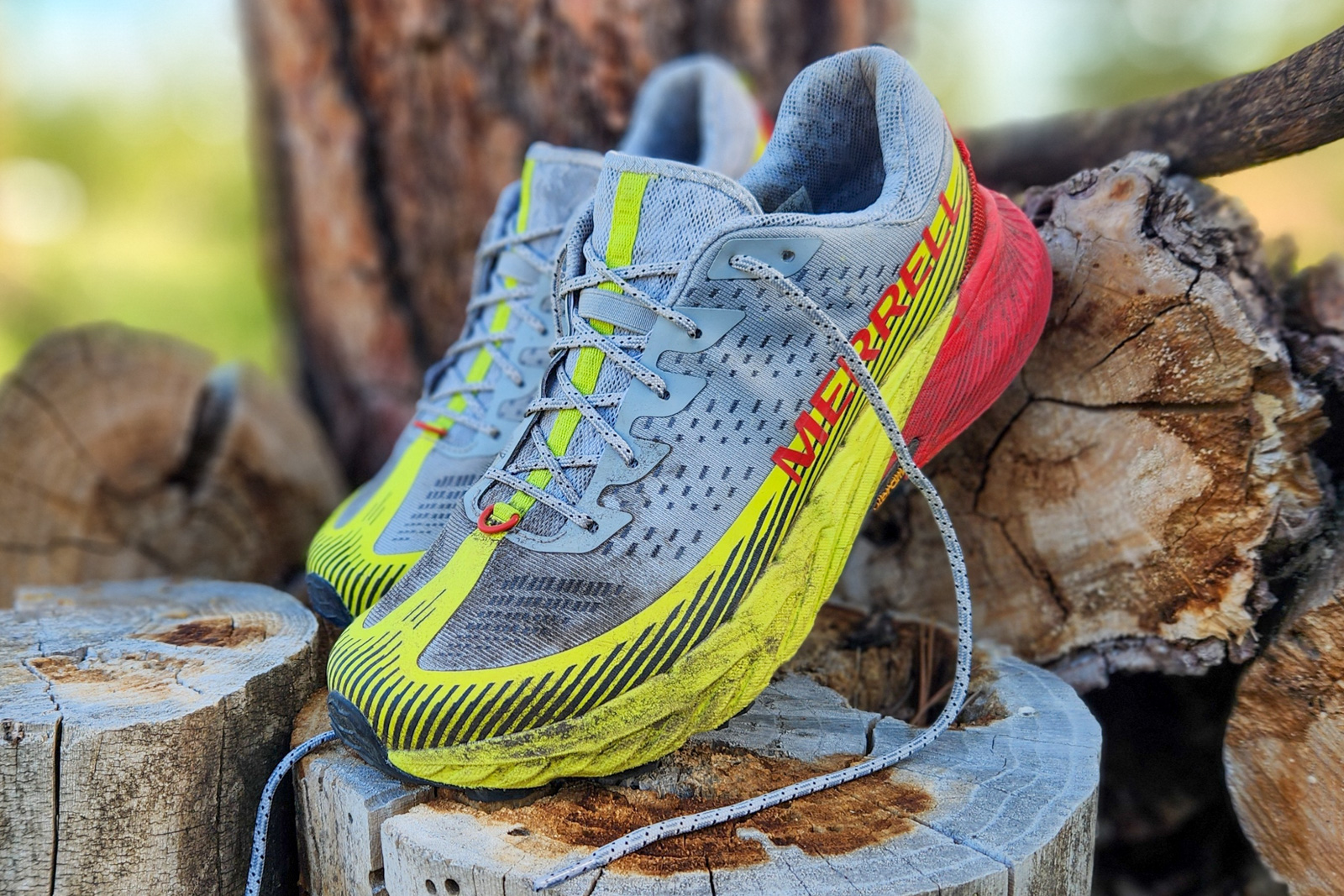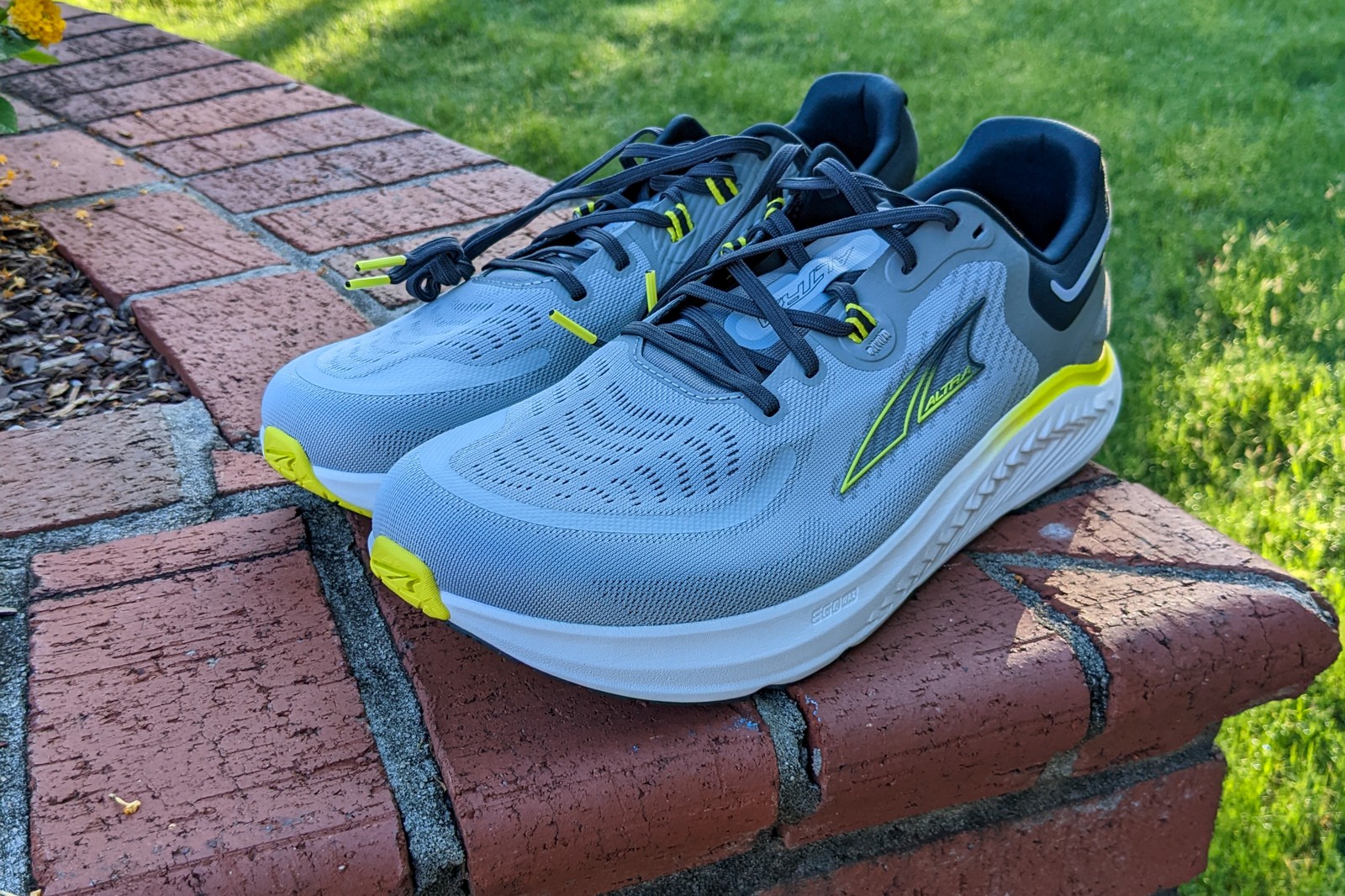
We independently review everything we recommend. When you buy through our links, we may earn a commission.
10.6 oz. (300 g) for a US M10,
8.8 oz. (249 g) for a US W8
38.5 mm in heel, 30 mm in forefoot (8.5 mm drop)
Non-technical terrain on race day, up to any distance
Vibram Litebase with Megagrip outsole, carbon Flyplate, fabric-wrapped ZoomX midsole, Vaporweave upper
August 1 for $260
ROBBE: My most love/hate relationship with any brands is probably that of Nike Trail. I perpetually love the designs, the look, even the fit of the shoes– seriously, I think Nike trail gets their color palettes from a fourth dimension because year after year, nobody comes close. As part of the everlong quest of balancing design with function, Nike’s attention to detail is always industry best. However on the seesaw of both, it seems the design side had its ass on the ground more often than not.
Much of that imbalance was thanks to Nike’s persistent refusal to use anything other than their in-house outsole rubber, which was lacking. And by lacking, I mean it was the worst outsole rubber in the entire trail market. We’ve opined the matter for years, I won’t keep beating a dead wildhorse.
All that’s changed with the Nike Ultrafly, a race day trail shoe featuring, yes– the coveted Vibram Litebase with Megagrip outsole– as well as a ZoomX midsole wrapped in fabric, full-length carbon fiber Flyplate, Vaporweave upper, and so much more. Everyone’s been wondering– can Nike take the race day magic of its road shoes (Vaporfly and Alphafly) and translate it to trails? Turns out, it can. Kind of. Sometimes.
Let’s see how.
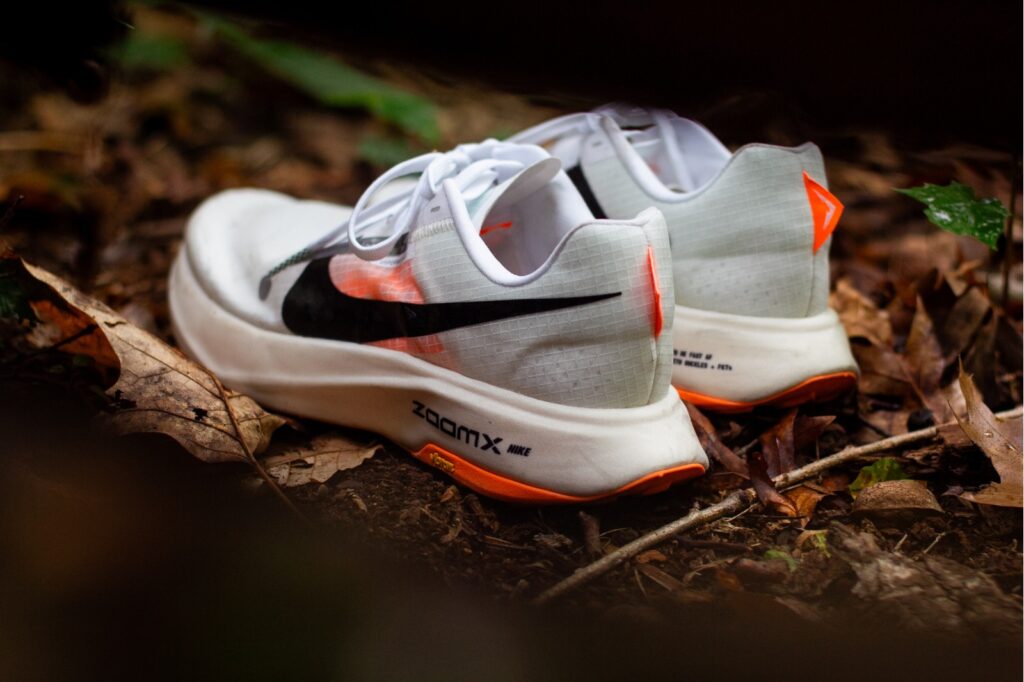
First appearance of ZoomX in a trail shoe
ALEX: The Ultrafly is here at last. It’s the first time a carbon plate meets a full ZoomX midsole on the trails. The Carbon fiber Flyplate is designed to be more flexible and adaptable over varied terrain than the plates you find in the Vaporfly and Alphafly.
Of course, the main attraction here is the shiny new Vibram outsole. Took ya’ long enough, Nike. It’s good to see Nike taking steps to boost its trail racing profile, but for several reasons that I’m about to lay out, it didn’t quite work for me.
MATT: Talk about anticipation — at least unless your name is Ben Johnson (hi Ben!). I feel like I’ve been waiting over a year, possibly closer to two, for the Nike Ultrafly to become a reality and land on my porch.
Naturally, when Nike does something big, there’s no bigger hype train in the running world, and the Ultrafly marks two major firsts for the company:
On paper, we’re essentially talking about a Vaporfly for the trails, and one with proper outsole rubber that won’t have you slip and fall in a wet grocery store aisle — let alone on a slippery trail. This is a shoe that just took two-thirds of the podium spots at Western States 2023– could the excitement even go any higher? Of course, that race and that course is a bit different from the East Coast trails we play around on, so I was interested to see if this was a one-trick pony or a throw-anything-at-it kind of shoe.
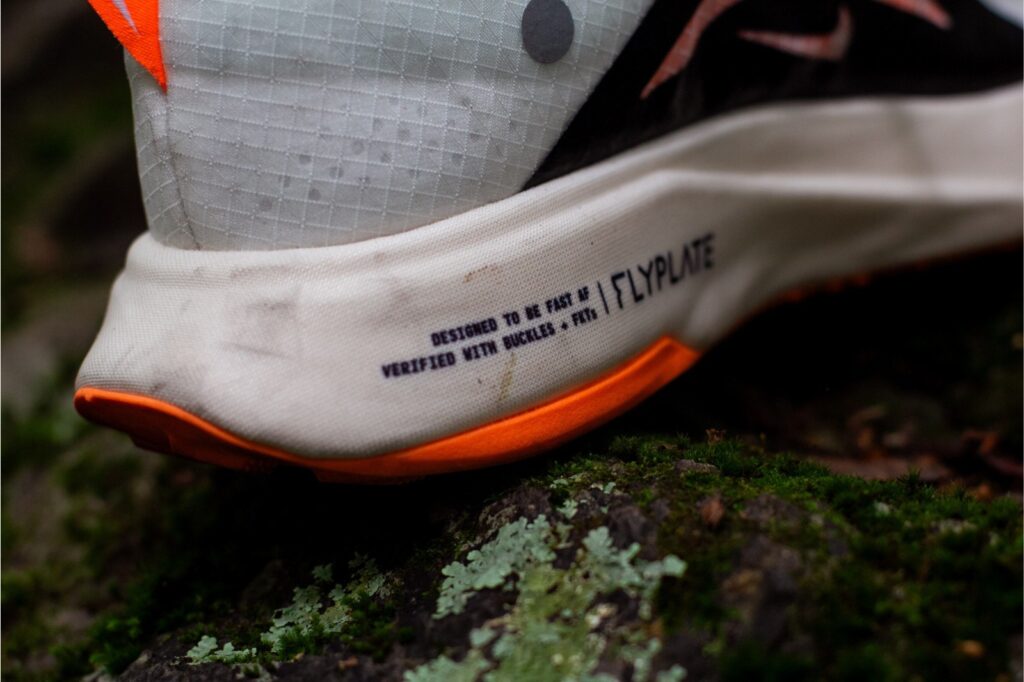
ZoomX midsole is fully wrapped in a cordura-like fabric
ROBBE: At first glance, there’s a lot to love about this shoe, and by a lot, I mean everything. I already gushed about the Nike design team’s prowess, but this shoe is peak Nike Trail. From the lateral silver foil label to the heel pull tag to the checkered flag racing tips on the laces, everything about this shoe is beautiful. Every detail pops against the all white, and the complementary Nike orange elements are just perfect. I want to keep going, but my gushing is getting gross.
Out of the box and on the feet, the first thing I noticed was the width– Nike is known for its narrow last, and the Ultrafly is wider than normal, especially in the toe box, which provides plenty of room for splay. I typically love the narrow shape for my narrow foot, but I really appreciated the bit of extra room at first (we’ll revisit this later).
I had these for a week before I could hit the trails and I wore them every day for walking and general wear. I have to say, it may be the one of the most comfortable shoes I’ve ever worn. Normally, a carbon-plated shoe will give me foot pain if I try and wear it all day (The North Face Vectiv Pro), but not so with the Ultrafly. I think this is partly due to the lower plate placement in the forefoot (you can see the outline of the plate structure on the midsole lines).
Of course, this shoe isn’t made for walking, so let’s move on.
At 38.5 mm, the ZoomX midsole is just a hair lower stack than its racing counterpart in the Vaporfly, but it doesn’t feel nearly as unstable, for a couple reasons. First, it’s lower (barely). Second, it’s entirely encased in a cordura-like fabric, which does double duty by protecting the ZoomX from getting chunked on rocks. At the same time, the fabric keeps the ZoomX corralled in order to maintain a semblance of stability. Additionally, the Vibram underfoot is a full slab, so essentially, you’re getting an entire box-like structure around the ZoomX. This is an exceptional design element– reigning in the instability of ZoomX is a feat to be admired. I think most people will overlook it, or complain about it because the fabric gets real dirty real quick.
It’s exceptional because nobody has figured out how to put race day foams on the trail without putting ankles in jeopardy. The Saucony Endorphin Edge is fast, but dangerously unstable. The Adidas Terrex Speed Ultra is light and lower stack, but sits on a narrow platform. The Hoka Tecton X 2 is a great racer (probably the best one at the moment), but it still doesn’t have that magical Pebax feel. I think Nike has come super close to figuring it out with the Ultrafly.
Because when the midsole comes to life, it’s go time. On non-technical single-track or fire roads, or even regular roads, this thing flies. And it feels like that incredible ZoomX race day feel we know and love. Even at a weight that’s slightly higher than the Pegasus (it is a trail shoe after all), it feels fast and fun. I have to say, this may be one of the best Nike road shoes, certainly light years better than the Zoom Fly. It’s feels like a more built-up version of the Pegasus Turbo 2.
And then there’s the Vibram outsole. Thank you, a hundred times over, for finally using Vibram. Anyone who’s used Vibram know that it’s the king of trail for a reason– it deftly balances stickiness with durability, lasting as long as the midsole while giving you the needed security over any terrain. While this isn’t an overly-aggressive outsole (the lugs are only 3.5 mm), it’s enough to get the job done. So no, this isn’t meant for mud and muck, but it will handle wet and wild. I even wore this on a rainy day run in the city, and it held up to all types of slippery surfaces (even deadly crosswalk paint).
Lastly, the ripstop-style Vaporweave upper is breathable, light, comfortable, and pretty much perfect. Keep that comng.
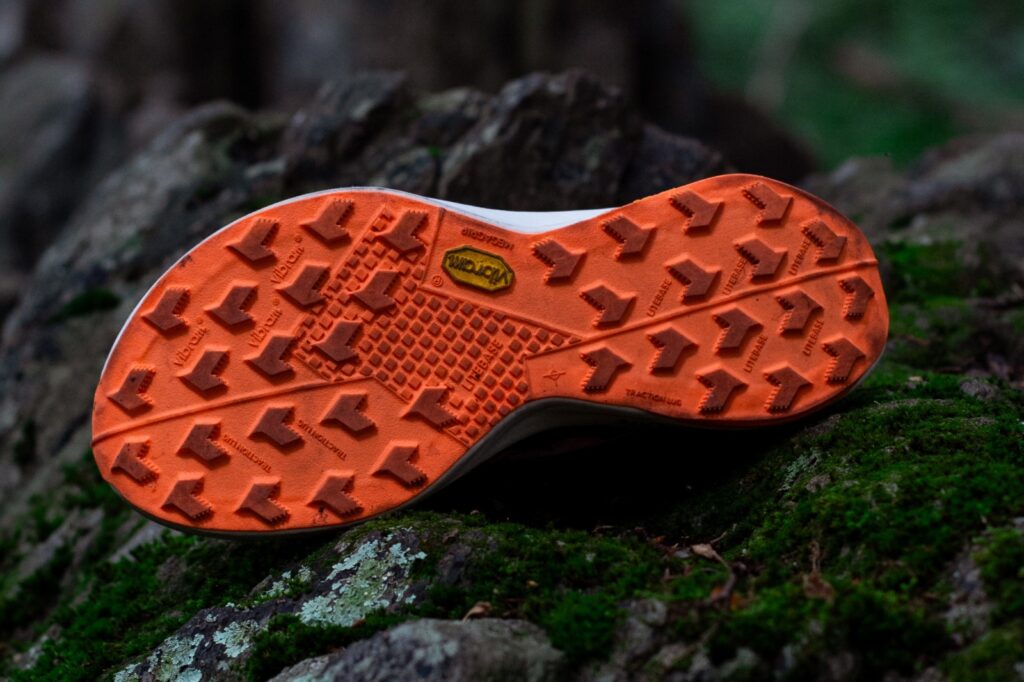
The all-new Vibram Megagrip outsole sticks to everything
ALEX: The overall aesthetic of the Ultrafly is clean and beautiful. I love the colorway and well-placed details. Nike Next% fans will recognize the lightweight Vaporweave upper in an instant. It’s extremely lightweight and breathable. Whenever I get a white trail shoe, I always want to save it for a dry day on the trails, but with Nike adopting a Vibram Litebase outsole, I just couldn’t wait to get out for a test. That nice white upper paid the price, and unfortunately, so did my ankles. More on that in the next section.
The Ultrafly has a roomier fit than I expected, especially in the toe box, but it fits true to size and was comfortable on smooth, rolling terrain. Nike’s trail racer also performed well on the roads. In fact, it’s quickly become one of my favorite road runners. The plush midsole allows for natural foot movement and, paired with the carbon plate, provides a springy, responsive ride that feels fast and light.

I mean, it’s a beautiful shoe
MATT: As Alex stated, it’s very rare that Nike ever misses from an aesthetic perspective with a new model, and they certainly didn’t let us down with the Ultrafly. Clean, crisp, and fast are words I would use to describe the Ultrafly. The use of white and off-white really gives the shoe a distinct and classic look, and overall it really does look like a relative of the Vaporfly.
Also, as a descendant of the Vaporfly, the Ultrafly inherits the comfortable, airy, light Vaporweave upper that we have come to love on the roads. While I am unsure of its function, and added sharkfin off the heel looks like a spoiler on a racecar. Subtle distinction.
I also love the feel of the ZoomX midsole in its latest application. The stack maxes out at about 38.5 mm in the heel (30 mm forefoot for an 8.5 mm drop), and it really doesn’t feel like too much, even on some more technical trails. I never felt out of touch with the ground while adding up the miles. Of course, some of that may also be thanks to the Vibram outsole. While most will be focused on the carbon plate, I actually think Nike’s biggest and most valuable advancement with the Ultrafly is the use of Vibram rubber on the outsole. This has been the one consistent downfall of every single Trail model I have tested over the years. No matter how much I loved the design, how comfortable the ride was, or how light and fast the shoe felt, none of that could overshadow the fact that I knew I was risking a fall and injury with the first wet rock or root I ran over.
Knowing that I had security underfoot with the Ultrafly is a huge deal for Nike on the trail.
With how great the ZoomX and carbon plate combo was for Nike on the road, I found myself running a bunch of mixed terrain routes so I could put it to the test on the blacktop as well as the dirt. I’ll be honest, aside from the shoe being a bit loud, the Ultrafly felt right at home. I even took it out for a pure 10k road run, and it felt great the whole time. On the trails, while few and far between, when I would hit some straightaways and flat sections, including some grass fields and fire roads, I could really open it up and feel the bounce and energy of the shoe shine.
Shop Nike Ultrafly - Men Shop Nike Ultrafly - Women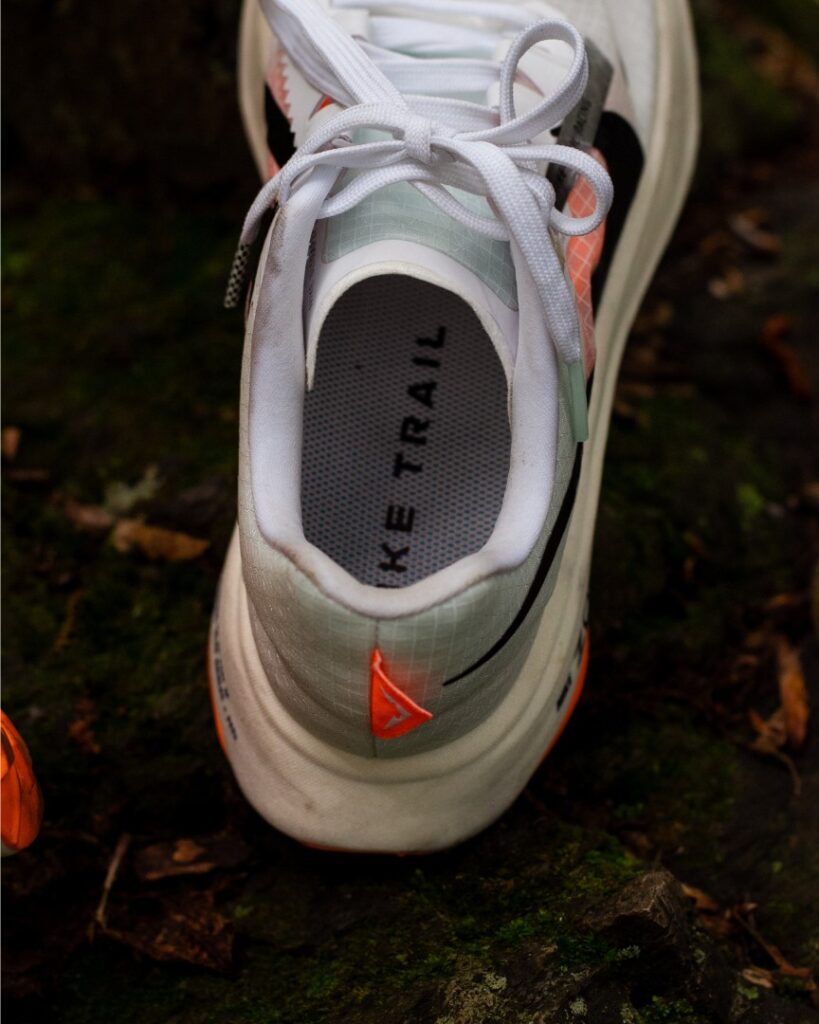
Capture the flag pull tab

Look great, get dirty quickly
ROBBE: I wanted so bad for this section to be blank, but there are some concerns with the shoe, depending on the terrain. I want to preface this section by noting that this is a race day shoe, and it’s a race day shoe designed for lighter surfaces– think groomed trails, fire roads, non-technical single track. Think Western States. With lighter lugs, an almost non-existent toe bumper, and a high stack of foam. Most of this bad has to do with surfaces that are not that.
I took this out for miles on the Appalachian Trail in Pennsylvania, which probably ranks as one of the dumbest trails in the world for trail running. Every time I’m on it, it blows my mind that Scott Jurek and others have run 50+ miles a day on it in pursuit of the trail’s FKT. It’s just a pile of rocks with some dirt thrown in.
Don’t wear this shoe on those trails. While the Vibram sticks to everything it touches, there’s plenty of movement in the upper and it was impossible to get a good lockdown without cutting circulation off to the top of my foot. I laced and relaced multiple times and still found myself sliding all over the place on uneven surfaces.
While Nike did its best to tame the ZoomX, it’s still unstable. It’s not the worst, and I think they did a pretty great job with it, but Pebax is gonna Pebax. Luckily, I never properly rolled one during the run, but my ankles were sore as hell after the run and into the next day.
On steep uphills, I did experience a bit of heel lift thanks to the stiffness of the Flyplate. Not a dealbreaker, though.
The shoe gets dirty, quickly. I think of it as a canvas to paint, but at its price tag, others may want to keep it pristine. Not gonna happen. The cordura wrap on the midsole turns brown as soon as it hits dirt and it’s not coming out (maybe with OxiClean, but can’t confirm).
The shoe is $260, which puts it right between the Vaporfly and Alphafly, and makes it the most expensive trail shoe from a major manufacturer (by far). As far as we know, in the entire trail sector, the price tag only sits below Norda and Speedland. That’s a lot, but the shoe does have literally every premium component in the Nike toolbox. People will buy it.
ALEX: The ZoomX midsole is wrapped in a durable fabric that absorbs and holds dirt. My first outing was on wet muddy trails, and almost immediately, the beautiful Ultrafly turned completely brown. Game over for the beautiful aesthetic.
While the Vibram outsole greatly improves grip and traction, the lack of upper stability undoes this major improvement. They are not good on technical terrain or trails that are off-camber. I wanted to run fast in the Ultrafly, and when I tested it over varied terrain, I twisted and rolled my ankle numerous times. The same happened on steep descents — because of the roomier toe box and lack of midfoot stability, I had no confidence, and the ride felt unstable.
There is very little protection built into the upper, my toe hooked a root, and not only did I fall on my face, the top of my foot hurt for the rest of the day. To make matters worse, the fully gusseted tongue stayed in place though it rubbed on the front of my ankle and caused a blister.
Additionally, in an attempt to compensate for the insecure fit of the upper, I ended up lacing the shoe too tight, which caused my foot to go numb and discomfort over the top of my metatarsals. The stiffness of the plate might have also contributed to this sensation.
At $260, this one is a hard pass for me. I’ve been wearing the Ultrafly on gravel and pavement, and without the true trail versatility, I think it’s a hard sell. Maybe wait for a few versions from now so that Nike can add a trail upper to the Vibram outsole. Baby steps. In the meantime, I’ll be hanging out in the Hoka Tecton X 2.
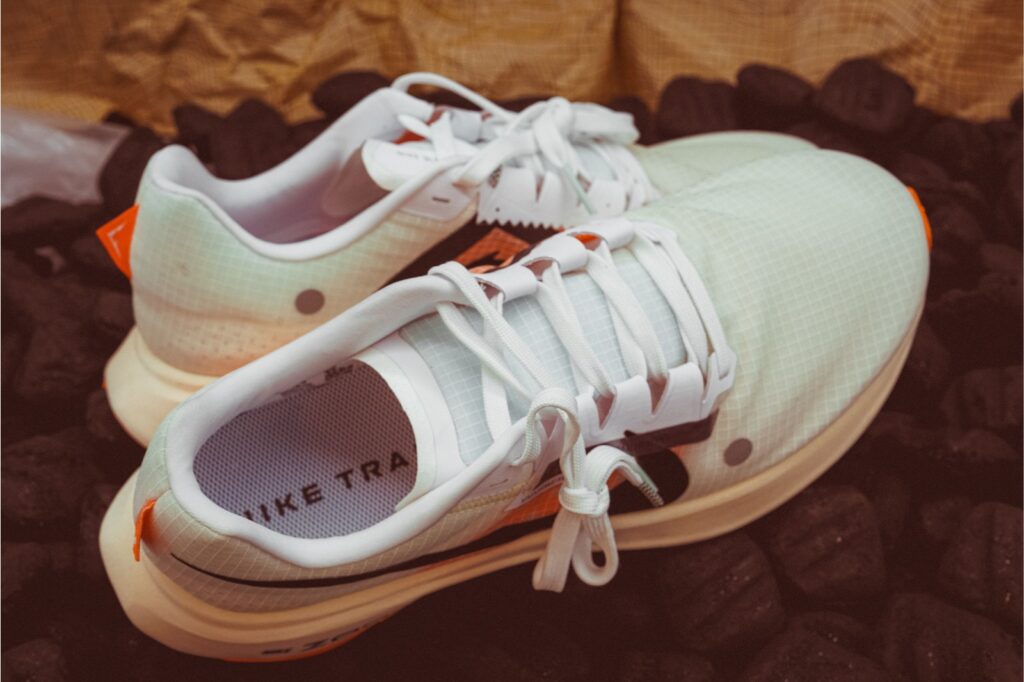
MATT: There are a lot of really good design choices within the Ultrafly, and within the right conditions, I can see this being the weapon of choice for many front-of-the-pack athletes. However, there are some major fundamental flaws with the shoe that will limit its function to the masses.
First, can brands start officially labeling trail shoes as West Coast or East Coast? I mean, the difference in the terrain is almost as drastic as a road or trail shoe, so maybe that additional classification would help temper expectations. The Ultrafly is not the first shoe to let me down by its inability to handle East Coast terrain (Hoka Zinal, Saucony Endorphin Edge).
As Alex mentioned above, the Ultrafly may as well be a road or gravel shoe. There’s next to no protection around the upper and toe box, so you’ll be taking the full impact of any kicked rocks or roots you might trip over, and the lateral stability feels like you could spill out of the shoe or fold your ankle each time you make a sharp turn or attempt to wind your way through the single-track.
I also felt as if the already minimal 3.5 mm lugs were even smaller in reality, as my crude measurement had them barely hitting 3 mm. This, again, is just enough extra grip to help cut across packed dirt and non-technical trails out West, but would never be able to handle wet or muddy conditions. The fact that the Ultrafly can perform so seamlessly on the roads is also a testament to the lack of aggressive design in the shoe’s outsole.
Finally, the Ultrafly felt a bit big in the toebox, and I would say, at minimum, a half-size too large for my ideal fit. The fit was ok in the heel and midfoot, so I’m not sure if this could be solved by going a half size down or if this is purely a design flaw in the toebox, but it added to the insecurity I had, especially highlighted on downhill sections.
Shop Nike Ultrafly - Men Shop Nike Ultrafly - Women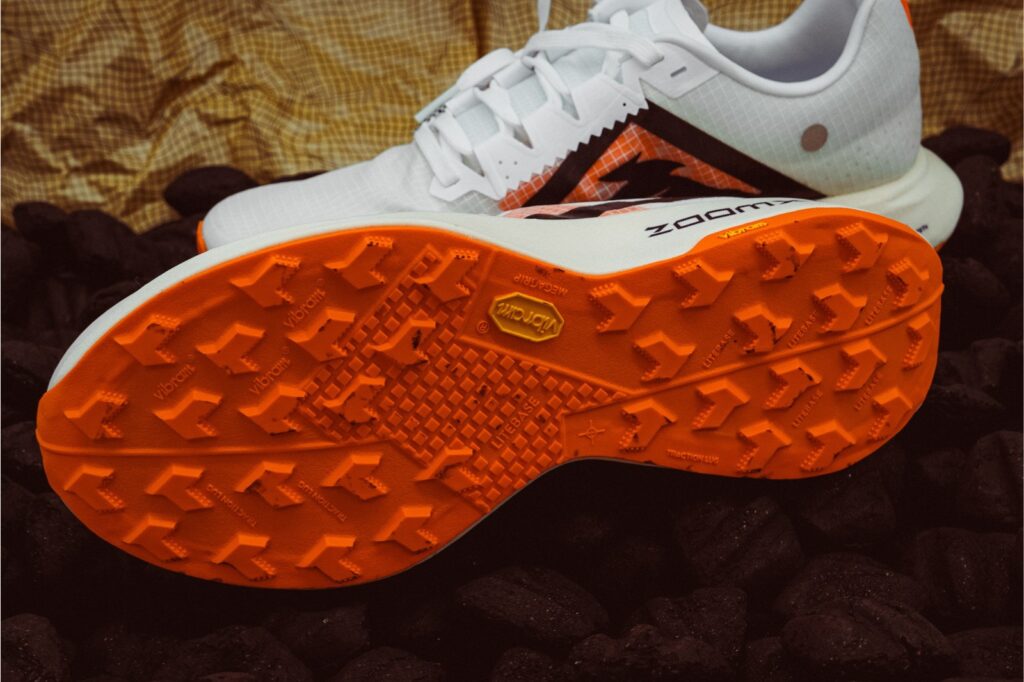
ROBBE: Man, I love this shoe so much in certain conditions, but when the going gets tough, this shoe gets going– to the trunk of the car. For anything slightly off-camber or technical, I’m going with something with either better lockdown, lower stack, or more structure to the upper, something like the Topo Athletic MTN Racer or again, the Hoka Tecton X 2.
However, if money isn’t an object to you, but trail running on the West Coast is, then by all means– go for it. You’re gonna love the way it runs.
And if money really isn’t an object to you, and neither is trail running, then this is actually one of the most comfortable shoes, period. I’m still going to rock it for casual wear because it may look better than it actually runs.
Now, to douse it in a bucket of OxiClean…
ALEX: Everything in me wanted to love this shoe, especially with the addition of the Vibram outsole. And it is a great shoe for certain terrains, but at $260, its lack of versatility renders it a no-go for me. If you have the cash and you live in one of those trail paradise places out West, then by all means– go for it. I’ll stick with some of the more conservative options for now.
MATT: Overall, at the price point of $260, unless you primarily train and race out West and aren’t concerned with technical and rocky terrain, I just can’t justify spending that kind of money on the Nike Ultrafly. The shoe does have some really nice qualities, and I’m convinced that if you inserted this shoe into the Nike road lineup tomorrow, it would be one of its best offerings. But as a trail racer, it just falls really short.
As Nike always seems to do, it will hopefully build on this original version and address the security and stability shortcomings so we can truly see a Nike ZoomX trail racer in the near future. In the meantime, I hope the decision to use Vibram on the Ultrafly outsole sets a new standard for Nike, and we start to see its application across the board, as I would be super excited to run in a Vibram-equipped Pegasus Trail, Wildhorse, or Zegama in the future.
You can pick up the Nike Ultrafly for $260 on August 1, 2023, directly from Nike by using the shop links below.
Want to learn more about how our review process works? Check out this guide.
Have something to say? Leave a Comment

Robbe is the senior editor of Believe in the Run. He loves going on weird routes through Baltimore, finding trash on the ground, and running with the Faster Bastards. At home in the city, but country at heart. Loves his two boys more than anything. Has the weakest ankles in the game.
More from Robbe
Alex is a trail and ultra runner from the upper midwest who loves Minnesota’s long winters and logging miles on the rooty, rocky, steep trails of Lake Superior’s North Shore. She was the first female to set a supported FKT on the 310 mile Superior Hiking Trail (SHT) and enjoys multi-day events and races, especially if they involve snow and -20 degree temps.
All-time favorite shoes: Hoka Speedgoat Evo, Hoka Tecton X, Altra Timp.
More from Alex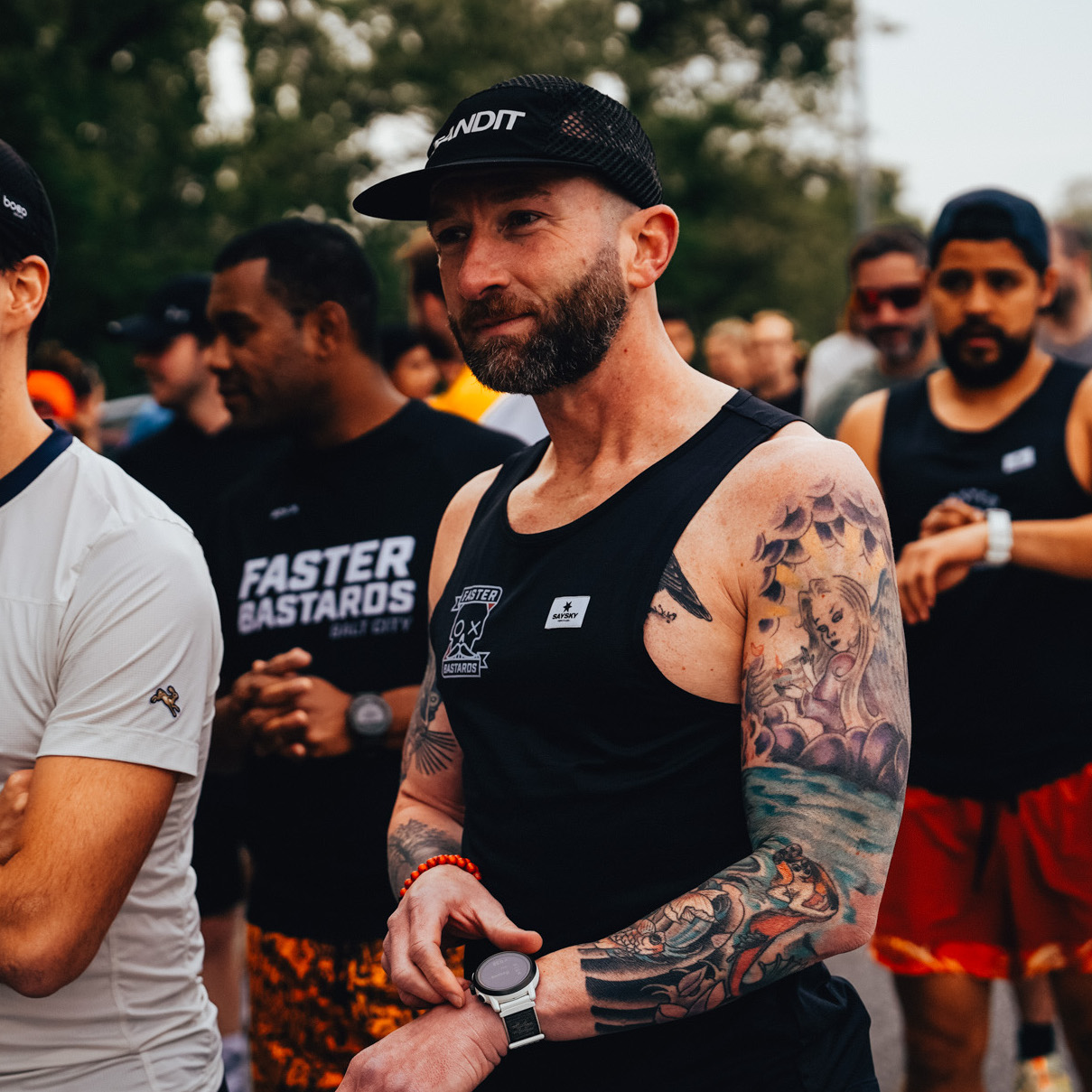
Matt is a recovering triathlete who fell in love with running and left the dark side behind. Trail and ultra running are where he is most in his element, but he can still be found routinely running the streets in and around Baltimore with the Faster Bastards. Aside from running, he is a lover of coffee, mezcal, beer, and 90s country music.
More from Matt